
JOURNAL OF PHARMACOLOGICAL AND TOXICOLOGICAL METHODS
Scope & Guideline
Transforming insights into actionable drug development strategies.
Introduction
Aims and Scopes
- Pharmacokinetics and Pharmacodynamics:
The journal extensively covers studies related to the pharmacokinetic profiles of drugs, including absorption, distribution, metabolism, and excretion (ADME). This includes innovative methodologies for assessing drug efficacy and safety in preclinical models. - Cardiovascular Safety Pharmacology:
A significant focus is placed on cardiovascular safety assessments, utilizing advanced techniques such as telemetry, electrocardiography, and human-induced pluripotent stem cell-derived cardiomyocyte assays to evaluate drug-induced cardiac effects. - Neurotoxicity and CNS Safety:
Research on the central nervous system (CNS) and neurotoxicity is a core area, with methodologies aimed at assessing drug effects on neuronal function and behavior, including in vitro models using human iPSC-derived neurons. - Toxicological Assessments:
The journal publishes findings on various toxicological assessments, including in vivo and in vitro studies evaluating drug safety, adverse effects, and mechanisms of toxicity, thereby providing insights into the safety profiles of pharmaceutical compounds. - Innovative Analytical Techniques:
There is a consistent emphasis on the development and validation of novel analytical techniques such as LC-MS/MS and in silico models, which enhance the reliability and accuracy of pharmacological and toxicological evaluations.
Trending and Emerging
- Human iPSC-Derived Models:
There is a marked increase in research utilizing human-induced pluripotent stem cell (iPSC)-derived models for drug testing, particularly in cardiotoxicity and neurotoxicity assessments, providing more relevant data for human applications. - In Silico Modeling and Computational Approaches:
The integration of in silico modeling techniques for predicting drug interactions and safety profiles is gaining traction, allowing for more efficient drug development processes and risk assessments. - Real-Time Data Monitoring Technologies:
Emerging trends include the use of advanced telemetry and real-time monitoring technologies that enhance the assessment of physiological responses in preclinical studies, improving the accuracy of safety evaluations. - Multi-Modal Drug Safety Assessments:
Research that combines various methodologies, such as electrophysiological assessments, biochemical markers, and imaging techniques, is on the rise, reflecting a holistic approach to drug safety and efficacy evaluations. - Regulatory Science and Best Practices:
There is a growing emphasis on regulatory science and the implementation of best practices in pharmacological testing, aligning research with evolving regulatory frameworks and guidelines to ensure drug safety.
Declining or Waning
- Traditional Toxicology Testing Methods:
There is a noticeable decline in studies utilizing traditional toxicology testing methods, as the field moves towards more innovative and predictive models, particularly those integrating human iPSC technology. - Single Species Animal Models:
Research using single species animal models for pharmacological testing is waning, with a shift towards more complex models that better mimic human physiology and disease states. - Basic Pharmacological Studies:
Basic pharmacological studies that do not incorporate advanced methodologies or translational relevance are less frequently published, reflecting a trend towards more applied and clinically relevant research. - Invasive Procedures in Animal Testing:
There is a gradual decline in the use of invasive procedures for drug testing, as ethical considerations and regulatory changes promote the adoption of non-invasive and reduced-refinement approaches.
Similar Journals

NAUNYN-SCHMIEDEBERGS ARCHIVES OF PHARMACOLOGY
Championing Excellence in Pharmacological ResearchNAUNYN-SCHMIEDEBERGS ARCHIVES OF PHARMACOLOGY is a prestigious journal published by SPRINGER, focusing on the dynamic fields of pharmacology and toxicology. With an ISSN of 0028-1298 and an E-ISSN of 1432-1912, this esteemed publication has been a staple in the scientific community since its inception in 1969, continuing to wield influence with a convergence of research that reaches through 2024. Ranked in the Q2 category for both medicine and pharmacology, it stands at an impressive 111th out of 313 in the Scopus rankings for pharmacology, reflecting its significant impact in the field. Though not offering open access, the journal remains a vital resource for researchers, professionals, and students seeking to explore groundbreaking studies and advancements in pharmacological science. With its high standards and comprehensive coverage, NAUNYN-SCHMIEDEBERGS ARCHIVES OF PHARMACOLOGY is essential reading for those dedicated to understanding the mechanisms of drug action and the complexities of therapeutic interventions.
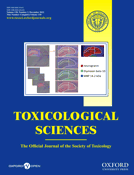
TOXICOLOGICAL SCIENCES
Innovating Understanding in Toxicological SciencesTOXICOLOGICAL SCIENCES, published by Oxford University Press, is a premier journal in the field of toxicology that has been a cornerstone of scientific discourse since its inception in 1981. With an impressive 2023 impact factor and ranked in the Q1 category for Toxicology, this journal is highly regarded among researchers, professionals, and students dedicated to pharmacology and toxicology. The journal is committed to advancing the understanding of toxicological science, covering a breadth of topics that include the mechanisms of toxicity, risk assessment, and the regulatory aspects affecting public health. With an ISSN of 1096-6080 and an E-ISSN of 1096-0929, TOXICOLOGICAL SCIENCES facilitates open access scholarly work, ensuring that critical research reaches a global audience and promotes collaborative learning. As it converges towards 2024, the journal remains pivotal in shaping the future of toxicology research, providing insights that are essential for developing safer chemicals and protecting environmental health.
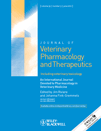
JOURNAL OF VETERINARY PHARMACOLOGY AND THERAPEUTICS
Empowering Animal Health with Cutting-Edge PharmacologyJOURNAL OF VETERINARY PHARMACOLOGY AND THERAPEUTICS is a crucial publication in the field of veterinary medicine, dedicated to advancing knowledge and practices related to pharmacology and therapeutic interventions in animals. Published by WILEY, this peer-reviewed journal has been a reliable source of innovative research since its inception in 1978, and it continues to play an integral role in shaping veterinary pharmacology through its commitment to high-quality scientific discourse. With an impact factor reflective of its robust academic standing, the journal is categorized in the Q3 quartile for Pharmacology and Q2 for Veterinary (miscellaneous) as of 2023, highlighting its relevance and significance within these domains. It is indexed in Scopus with commendable rankings, particularly in General Veterinary, where it ranks #45 out of 194, placing it in the 77th percentile. This journal not only offers a platform for original research articles but also caters to the dissemination of practical applications and reviews that are essential for veterinarians, researchers, and students alike in enhancing animal health and welfare. Although not an open-access publication, its contributions remain accessible to those engaged in the veterinary sciences through institutional subscriptions. The journal's enduring legacy and forward-looking approach make it a vital resource for anyone interested in veterinary therapeutics and pharmacology.

Toxicological Research
Bridging science and safety in the field of toxicology.Toxicological Research is a prominent academic journal dedicated to advancing the field of toxicology through rigorous exploration and innovative research. Published by the Korean Society of Toxicology, this journal serves as a vital resource for researchers, professionals, and students engaged in environmental science, pharmacology, and toxicology. With an ISSN of 1976-8257 and an E-ISSN of 2234-2753, Toxicological Research highlights significant findings and discussions in the realm of health, toxicology, and mutagenesis. Although not an open-access journal, it maintains a solid reputation as evidenced by its Q3 ranking in both health-related toxicology and general toxicology categories for 2023. The journal covers a broad spectrum of topics from fundamental research to applied toxicology and provides a unique platform for the dissemination of knowledge in a field that is increasingly relevant in today’s society. With an anticipated convergence period from 2008 to 2024, Toxicological Research continues to contribute vital insights to understanding the implications of toxic substances on health and the environment.
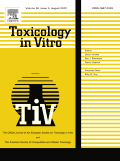
TOXICOLOGY IN VITRO
Empowering Researchers with In Vitro Toxicology AdvancesTOXICOLOGY IN VITRO is a premier journal published by PERGAMON-ELSEVIER SCIENCE LTD, focusing on the latest advancements in the field of toxicology, particularly through in vitro methodologies. With an ISSN of 0887-2333 and an E-ISSN of 1879-3177, this journal serves as a critical platform for researchers aiming to disseminate their findings in toxicology, emphasizing innovative approaches and applications in pharmacology and toxicology. Featuring a commendable impact factor and classified in the second quartile (Q2) for both Medicine (miscellaneous) and Toxicology in 2023, the journal holds a significant position within the academic community, ranking 41st out of 133 in the Toxicology category according to Scopus, representing the 69th percentile. Despite being a subscription-based publication, it continuously attracts submissions from leading scientists worldwide, fostering a vibrant exchange of scientific knowledge. Since its inception in 1987, TOXICOLOGY IN VITRO has consistently aimed to enhance understanding of toxicological challenges, making it an invaluable resource for professionals, students, and researchers dedicated to developing safer pharmaceuticals and understanding the biological pathways influenced by potential toxic agents.

TROPICAL JOURNAL OF PHARMACEUTICAL RESEARCH
Advancing pharmaceutical innovation for tropical health.Tropical Journal of Pharmaceutical Research is an esteemed open-access platform dedicated to advancing the field of pharmaceutical sciences, published by the Pharmacotherapy Group in Nigeria. With an ISSN of 1596-5996 and open access established since 2002, this journal serves as a critical resource for researchers, professionals, and students seeking to disseminate and access high-quality research in both pharmaceutical science and pharmacology. Despite its ranking in the third quartile (Q3) for Pharmaceutical Science and the fourth quartile (Q4) in Pharmacology as of 2023, the journal continues to stand out with its commitment to fostering significant dialogue and innovation in the scientific community. Anchored at the University of Benin, Faculty of Pharmacy, the journal invites contributions that explore novel pharmaceutical research, clinical applications, and drug development, playing a vital role in addressing health challenges that are particularly relevant to tropical regions. Researchers can look forward to publishing their findings in a journal that not only promotes the sharing of knowledge but also enhances the scientific discourse within a rapidly evolving field.
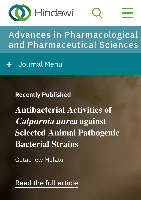
Advances in Pharmacological and Pharmaceutical Sciences
Unlocking the Future of Therapeutic Practices.Advances in Pharmacological and Pharmaceutical Sciences is a premier open-access journal published by Hindawi Ltd. based in the United Kingdom. Established in 2020, the journal swiftly garnered attention for its commitment to disseminating high-quality research in the realms of pharmacology, toxicology, and pharmaceutical sciences. It holds a commendable impact with notable quartile rankings, including Q2 in both Organic Chemistry and Pharmacology, indicating its importance within these disciplines. By embracing an open-access model, the journal ensures that research findings are widely available, promoting increased visibility and collaboration among researchers, professionals, and students globally. With an ongoing convergence of insights projected through 2024, Advances in Pharmacological and Pharmaceutical Sciences aims to address critical issues and advancements in drug development and therapeutic practices, making it an invaluable resource for those at the forefront of scientific inquiry in pharmacology and related fields.
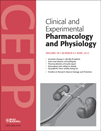
CLINICAL AND EXPERIMENTAL PHARMACOLOGY AND PHYSIOLOGY
Connecting Experimental Insights with Clinical ApplicationsCLINICAL AND EXPERIMENTAL PHARMACOLOGY AND PHYSIOLOGY, published by WILEY, is a premier journal that serves as a vital resource for researchers, professionals, and students in the fields of pharmacology and physiology. With ISSN 0305-1870 and E-ISSN 1440-1681, this journal has established itself as a significant contributor to scientific dialogue since its inception in 1974. Currently spanning until 2024, it consistently publishes cutting-edge research addressing both experimental and clinical advancements in pharmacology and physiology. Recognized for its quality, it holds a Q2 ranking in the 2023 Pharmacology category and notable Q3 rankings in both Physiology and Medical Physiology. The journal's coverage of topical issues not only ensures a robust platform for innovative findings but also fosters collaborations across disciplines. Although not an Open Access journal, its curated content is invaluable for advancing knowledge, as evidenced by its solid Scopus rankings, which place it within the top percentiles of its field. Engaging with this journal means staying at the forefront of research that shapes clinical practices and experimental methodologies.

Journal of Reports in Pharmaceutical Sciences
Advancing Pharmaceutical Knowledge, One Report at a Time.Journal of Reports in Pharmaceutical Sciences is a pivotal publication in the realm of pharmaceutical research, disseminating innovative findings that cater to the evolving landscape of pharmacology, toxicology, and biomedical engineering. Published by Wolters Kluwer Medknow Publications, the journal serves as a bridge for scholars and practitioners aiming to enhance their understanding of drug development, therapeutic advances, and biopharmaceutical technologies. With an ISSN of 2322-1232 and E-ISSN 2322-5106, it has established its relevance from 2012 to 2022, occupying notable quartile rankings, including Q3 in Pharmacology, Toxicology, and Pharmaceutics. Despite being categorized in Q4 in some areas, the journal's commitment to quality research ensures it remains a respected platform for disseminating significant insights. Researchers, professionals, and students alike will find this journal an indispensable resource for staying updated on critical advancements in pharmaceutical sciences, making it a go-to source for impactful studies that shape industry practices and academic inquiries.
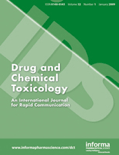
DRUG AND CHEMICAL TOXICOLOGY
Empowering public health through toxicology research.Drug and Chemical Toxicology is a well-respected journal in the fields of toxicology, pharmacology, and public health, published by Taylor & Francis Ltd. Since its inception in 1978, this journal has diligently explored the effects and mechanisms of chemical exposures on health and the environment, fulfilling a crucial role in advancing scientific understanding and safeguarding public health. The journal is indexed across prestigious databases and features an impressive array of articles categorized within the Q2 and Q3 quartiles across various categories in 2023, reflecting its significance in Chemical Health and Safety as well as Environmental and Occupational Health disciplines. With an extensive reach and a focus on interdisciplinary research, Drug and Chemical Toxicology offers a rich repository of original research, reviews, and methodological advancements, catering to a diverse audience of researchers, professionals, and students dedicated to the betterment of safety and health standards. Although not an open-access publication, its articles are widely accessible to the academic community, ensuring that critical innovations and insights are shared for the greater good.